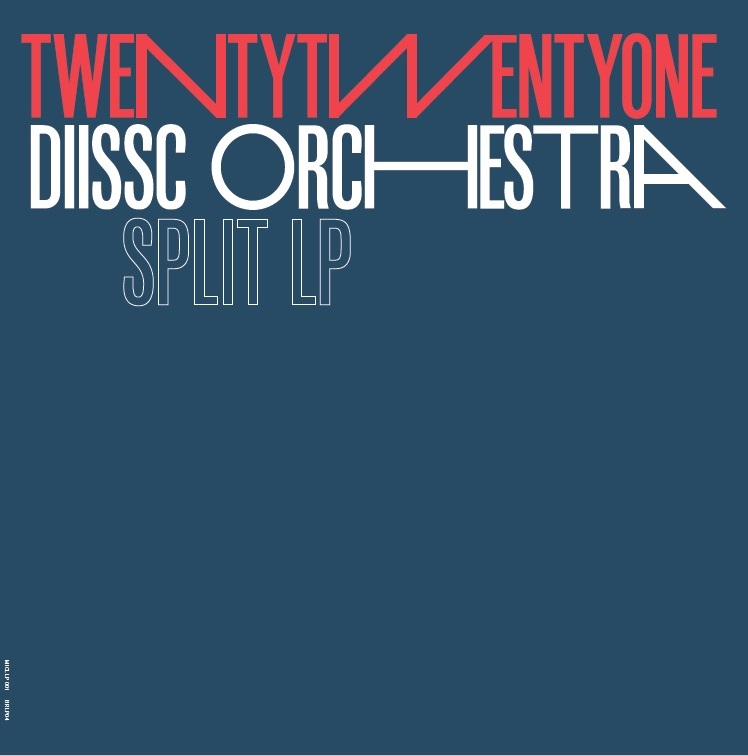|
Twentytwentyone, Diissc Orchestra – Split

|
Release Date: V 2018
Total Time: 42:25
LP
A
Twentytwentyone
1. 18, 17, 8, 30, 76 (Lina Lapelytė)
2. 24, 25, 26, 27, 28 (Antanas Dombrovskij)
3. 1, 2, 3, 4, 5 (Arturas Bumšteinas)
4. 53, 78, 110, 100, 38 (Vilius Šiaulys)
B
Diissc Orchestra
1. Vytautas V. Jurgutis. Tinohi (LP remix, 2017)
2. Jonas Jurkūnas. Venta lebewohl (LP remix, 2017)
3. Martynas Bialobžeskis. MY DO (2017)
4. Antanas Jasenka. exe.rpm (2012)
|
|
| The perennial question posed by a vinyl enthusiast is almost exactly the same as the one Alice asked herself (and the kitten) one winter afternoon, standing in front of the mirror: ‘What will I find on the other side?’ What is the logic behind the (sound) world on this and on the other side? A hit and its double, or a lyrical song and its dub version? In the case of the mirror and the vinyl record, the other side remains unceasingly a puzzle, a mystery piling up questions and inspiring curiosity. The logic and the policy of a digital recording and its typical carrier, which a compact disc has become, are completely different, while the vinyl record itself rather resembles Borges’ memorable ‘Disk of Odin’, which is the only thing in the world that ‘has just one side’. The other side doesn’t exist, and so the mystery vanishes. There’s no need to ask the question posed by Alice: are words the same there,
or are they written backwards?
|
Is it also the case with this album, in which the digital and analogue element meet on two sides of the vinyl record, made familiar by Lithuanian musicians? On one side of the record, we have the laptop quartet Twentytwentyone. The ensemble was founded in Vilnius in 2005, the members being four Lithuanian musicians: Arturas Bumšteinas, Lina Lapelytė, Antanas Dombrovskij and Vilius Šiaulys. Initially, their performances were sonic interpretations of graphic scores and moving images. The quartet use laptops as primary instruments for creating and performing music, but they also employ a wide range of other electronic and acoustic instruments (such as violin, flute, electric guitar, samplers, synthesisers, amplified objects, midi keyboards, etc). For this record, the artists have used selected pages from Cornelius Cardew’s Treatise (1967) as a visual inspiration for their sound material, which was composed by each artist individually, to be later put together in the studio. The text of Treatise is so ambiguous that, in fact, it is open to any reading, and situates every attempt at interpretation on the verge of cognitive anarchy.
On the other side, four original compositions are presented by the members of Diissc Orchestra, four Lithuanian composers: Martynas Bialobžeskis, Antanas Jasenka, Vytautas V. Jurgutis and Jonas Jurkūnas. The ensemble was founded in 2008; their starting point was compositions involving a variety of disc players, stopwatches, special graphic scores, and low-tech devices. This release will symbolically mark the tenth anniversary of their electronic music quartet. Jonas Jurkūnas’ Venta lebewohl 2017, a remix of Jurgutis’ piece Tinohi, which was introduced in the debut programme D.O, recalls Venta, one of the most memorable projects. In Martynas Bialobžeskis’ MY DO, several programmes from Diissc Orchestra are welded into one structure; and Antanas Jasenka’s exe.rpm represents rhythm and frequencies that were often part of the ensemble’s performances. The compositions encourage the listener to ‘read from vinyl records’, hence to interpret sound material that has already been recorded by someone else on a specific sound carrier. Similar media trigger a similar interpretation, if we can use such expressions at all in the world of technological hybrids. We listen, therefore, not so much to readings of the same musical text, as to its medium, vinyl records, played in a certain way (it doesn’t matter
whether or not it coincides with the producer’s intention), in order to conduct a reinterpretation of their content. Once again, the record becomes an object that is manipulated to receive sound from it, to let the matter it is made of speak, to give a voice to the material, which, seemingly silent, determines what we can hear. While listening to it, let us also try to imagine activities similar to those undertaken by the heroes of the album: reading architecture with the bow, interpreting classical scores by colouring them, or reading Proust’s novel reduced to listening to the rustle of the pages. |
|